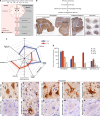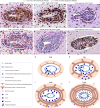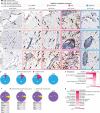Spatiotemporal profile of an optimal host response to virus infection in the primate central nervous system
- PMID: 39841753
- PMCID: PMC11753669
- DOI: 10.1371/journal.ppat.1012530
Spatiotemporal profile of an optimal host response to virus infection in the primate central nervous system
Abstract
Viral infections of the central nervous system (CNS) are a major cause of morbidity largely due to lack of prevention and inadequate treatments. While mortality from viral CNS infections is significant, nearly two thirds of the patients survive. Thus, it is important to understand how the human CNS can successfully control virus infection and recover. Since it is not possible to study the human CNS throughout the course of viral infection at the cellular level, here we analyzed a non-lethal viral infection in the CNS of nonhuman primates (NHPs). We inoculated NHPs intracerebrally with a high dose of La Crosse virus (LACV), a bunyavirus that can infect neurons and cause encephalitis primarily in children, but with a very low (≤ 1%) mortality rate. To profile the CNS response to LACV infection, we used an integrative approach that was based on comprehensive analyses of (i) spatiotemporal dynamics of virus replication, (ii) identification of types of infected neurons, (iii) spatiotemporal transcriptomics, and (iv) morphological and functional changes in CNS intrinsic and extrinsic cells. We identified the location, timing, and functional repertoire of optimal transcriptional and translational regulation of the primate CNS in response to virus infection of neurons. These CNS responses involved a well-coordinated spatiotemporal interplay between astrocytes, lymphocytes, microglia, and CNS-border macrophages. Our findings suggest a multifaceted program governing an optimal CNS response to virus infection with specific events coordinated in space and time. This allowed the CNS to successfully control the infection by rapidly clearing the virus from infected neurons, mitigate damage to neurophysiology, activate and terminate immune responses in a timely manner, resolve inflammation, restore homeostasis, and initiate tissue repair. An increased understanding of these processes may provide new therapeutic opportunities to improve outcomes of viral CNS diseases in humans.
Copyright: This is an open access article, free of all copyright, and may be freely reproduced, distributed, transmitted, modified, built upon, or otherwise used by anyone for any lawful purpose. The work is made available under the Creative Commons CC0 public domain dedication.
Conflict of interest statement
The authors have declared that no competing interests exist.
Figures








Similar articles
-
La Crosse virus infectivity, pathogenesis, and immunogenicity in mice and monkeys.Virol J. 2008 Feb 11;5:25. doi: 10.1186/1743-422X-5-25. Virol J. 2008. PMID: 18267012 Free PMC article.
-
Age-dependent myeloid dendritic cell responses mediate resistance to la crosse virus-induced neurological disease.J Virol. 2014 Oct;88(19):11070-9. doi: 10.1128/JVI.01866-14. Epub 2014 Jul 9. J Virol. 2014. PMID: 25008929 Free PMC article.
-
Innate immune response to La Crosse virus infection.J Neurovirol. 2014 Apr;20(2):150-6. doi: 10.1007/s13365-013-0186-6. Epub 2013 Jul 12. J Neurovirol. 2014. PMID: 23846288 Review.
-
Lymphocytes have a role in protection, but not in pathogenesis, during La Crosse Virus infection in mice.J Neuroinflammation. 2017 Mar 24;14(1):62. doi: 10.1186/s12974-017-0836-3. J Neuroinflammation. 2017. PMID: 28340587 Free PMC article.
-
Non-human primate models of SIV infection and CNS neuropathology.Curr Opin Virol. 2016 Aug;19:92-8. doi: 10.1016/j.coviro.2016.07.012. Epub 2016 Aug 18. Curr Opin Virol. 2016. PMID: 27544476 Free PMC article. Review.
Cited by
-
Age dependent susceptibility and immune responses to La Crosse virus infection in non-human primates.Sci Rep. 2025 May 13;15(1):16628. doi: 10.1038/s41598-025-01285-8. Sci Rep. 2025. PMID: 40360698 Free PMC article.
References
MeSH terms
LinkOut - more resources
Full Text Sources

